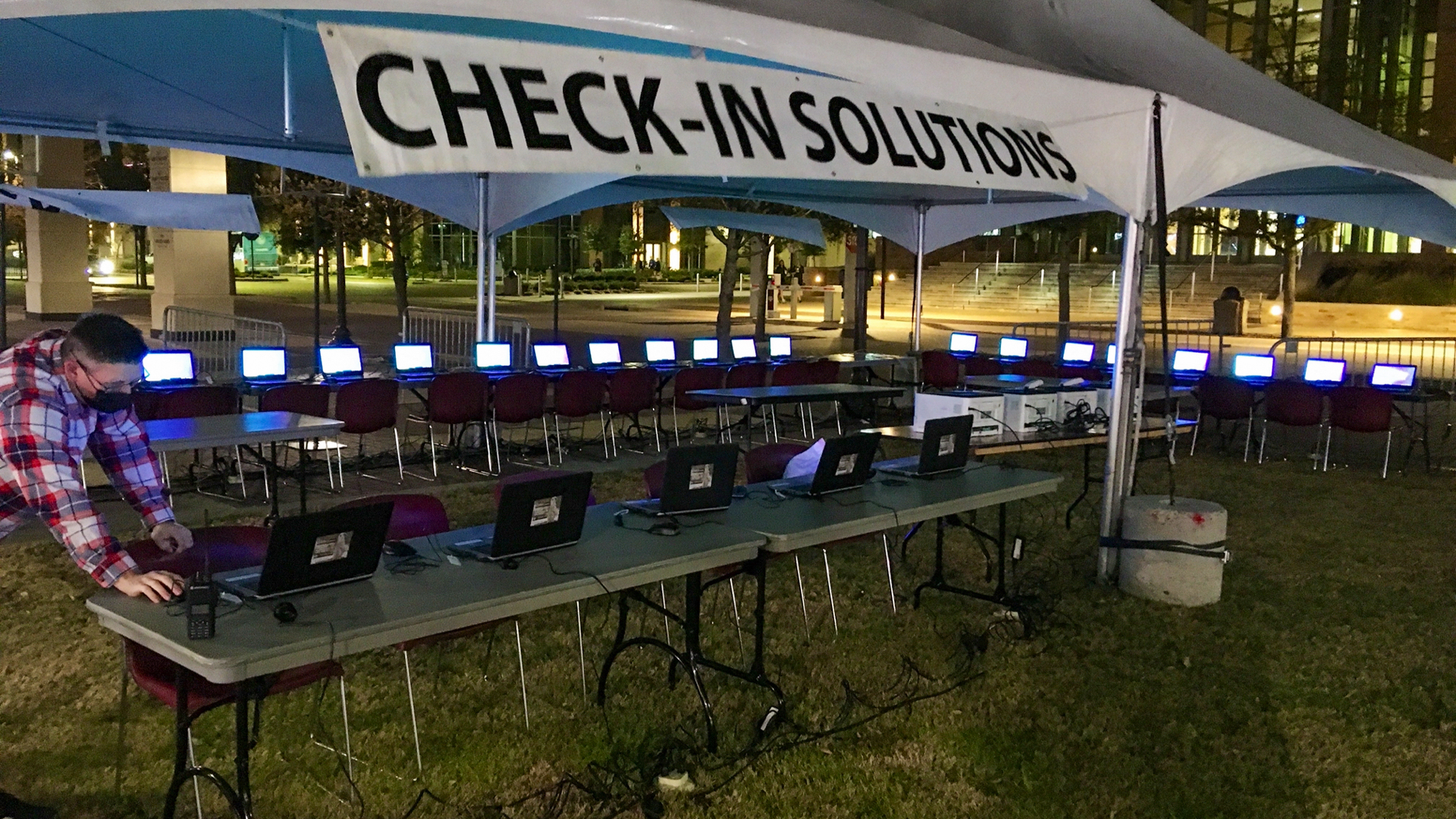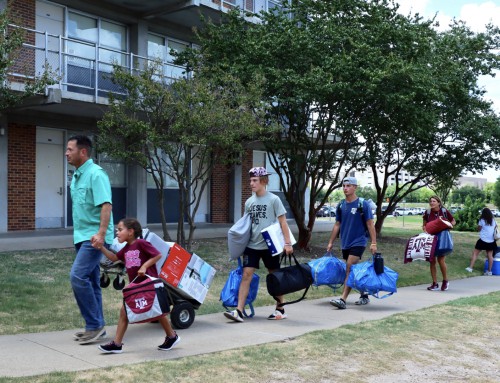
Japanese poet Ryunosuke Satoro wrote, “Individually, we are one drop. Together, we are an ocean.” That’s true when 13,200 students come together in selfless service. It’s also true when a variety of IT staff use their skills to serve a common purpose.
When The Big Event started forty years ago, the logistics were pretty easy to handle for six volunteers. Since then Texas A&M student volunteers have been an ocean making waves as they have completed more than a million service hours. The logistics have become more complex. IT services are essential for coordinating the effort that has engaged more than 22,000 students in a single day before the pandemic.

This year group check in was transformed using barcodes presented on mobile devices.
Online Application
For 11 years the Student Affairs IT Application team has partnered with The Big Event to provide a custom web application to manage job requests, volunteer signups, matching jobs to volunteer groups, volunteer check in, and incident management on the big day.
The application received several enhancements this year. In the past, group leaders had to attend an in-person session to get a printed record of their job assignment. This year all volunteers received an email with their job details and a map link to their job site. It also had a barcode for easy check in of their group. Developer Devang Mehta worked with graduate assistant Manoj Vuppuluri to add the job information email. He also worked with David Swanson to tweak the job matching algorithm.
Developers Donald St Martin and Mark Matusek joined on site to support the revised check-in process and help identify opportunities to improve the process further to handle record numbers of volunteers expected in the future. Data collected during check in provides solid evidence for process capacity planning.
“I enjoy getting to see our customers using a product we built for them to give back to the community. By extension we are making an impact on the community by what we’re providing,” said Mark.

Advance testing revealed fire ant infestation of outside fiber connections.
Network Service
Historically, the tens of thousands of students that assemble for check in can overwhelm local WiFi and cellular service, so wired network connections are used for check-in stations. For six years Raymond Martin in Athletics IT has been providing reliable network service for The Big Event at the Kyle Field Plaza. When testing outdoor network connections in February, he discovered the multimode fiber termination was damaged beyond repair by fire ants.
To help resolve the issue, he consulted with Josh Bartosh in the Division of IT Networking group. From his many years of experience working with the campus network, Josh was able to recommend where to pull the underground cable so it could be successfully spliced a day later.
Raymond welcomed the opportunity to serve again and arrived on site early the day of to provide wired connections to each station. Having gone two years without the big check in, he said, “It’s big! You miss seeing the students. It was nice to see everyone back out and wanting to give back to the community.” Raymond also has recommendations to simplify network services further next year.

Check-in setup began well before dawn.
Onsite Devices
To support the massive check-in process, the Student Affairs IT Service Desk loaned 30 laptops and four printers. After working with the customer to test equipment on site in advance of the big day, all laptops were perfectly configured with a custom image for the specific subnet, printers, and default home pages.
This was the first year for Service Desk staff members Omar Valenzuela and Nestor Diaz to support The Big Event, but they learned quickly and executed perfectly. With the help of student technicians Jason Holt and Landon Brown, they finished setting up equipment at 6:30 a.m. so Big Event students could receive on-site training before starting check in 45 minutes ahead of schedule.
Mac McGee, a senior business management major, worked with his Big Event staff partner to lead ten committee members, who in turn coordinated 50 student staff assistants who quickly checked in groups for about 1,800 jobs. “It went really well! I had an awesome team that was flexible, both my Big Event team and the A&M staff we worked with who made sure we achieved our main goal of serving the community,” Mac said. “If I had to do it, it would never have worked. It’s great having an awesome IT team that’s so dedicated to working with The Big Event.”

Last year’s operations center successfully used Cisco Jabber VOIP services with mobile devices.
Call Center Operations
After the volunteers checked in, the real work began. Volunteers picked up tools and headed to their job sites. The emergency response center received a steady flood of calls from volunteers and residents throughout the day.
Call center staff used a Cisco Jabber phone system that routed calls coming into the main number to 20 different laptops used to track incidents that could range from injuries to job cancellations. Although the VOIP configuration used for the call center is not a standard service offering, Sean Alexander, Chief VoIP Engineer, in Division of IT Telecommunications was able to arrange the exceptional setup.
Jacqueline Hall and Landry Rickabaugh, Big Event development executives, gave a big thanks for the phone service. “It worked seamlessly and enabled our team to receive over 500 calls. It also helped us ensure the safety and success of our 13,000+ volunteers and 1,800+ residents.”
The contribution of so many IT professionals enables a selfless service experience that is carried by the tide of Aggies moving across our nation and around the world. The effort of The Big Event has spread to over 100 universities throughout the nation as well as to several countries including Costa Rica, China, Germany, and Pakistan.
The Japanese poet was right that, together, drops become an ocean. Among the many Big Event volunteers this year was one freshman student from Japan. Coming to Texas, he has seen how big an ocean can be. Coming to Texas A&M, he has seen how, as one drop working with others, he can help create an ocean.
To all who helped make this possible, the Big Event staff say, “A Big Thanks!”




